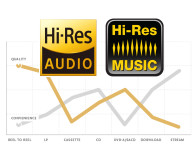 Why is it so easy to find an audio enthusiast claiming that his new headphones, DAC, preamplifier, or pair of speakers “completely changed his perception of the music” and “made it possible to hear things in a totally new way,” and yet so many consumers cannot actually hear the difference when listening to
Why is it so easy to find an audio enthusiast claiming that his new headphones, DAC, preamplifier, or pair of speakers “completely changed his perception of the music” and “made it possible to hear things in a totally new way,” and yet so many consumers cannot actually hear the difference when listening tohigh-resolution audio?
The difference in perceptions is precisely why I applaud initiatives such as the formal definition for High-Resolution Audio (HRA). HRA is defined as “lossless audio that is capable of reproducing the full range of sound from recordings that have been mastered from better-than-CD-quality music sources.” The formal definition was finalized in June 2014 by The Digital Entertainment Group, in cooperation with the Consumer Electronics Association (CEA), The Recording Academy, Sony Music Entertainment, Universal Music Group, and Warner Music Group.
This represents a “promotional effort” by interested parties. But wasn’t the same thing necessary when we transitioned to vinyl, reel-to-reel magnetic tape, cassette, 8-track, and compact disc (CD)? However, not all of them represented a quality increment in consumer perception. Some transitions were simply based on convenience (e.g., digital music distribution in compressed formats) and it will continue to happen as we pursue the convenience of wireless audio.
Appreciating that “perception” is “the way in which something is regarded, understood, or interpreted” (as defined by Oxford Dictionaries), it also directly relates to “one’s willingness to actually think about, understand something or notice something easily using one of our senses” (Merriam-Webster Dictionary).
Some people dedicate their lives to the continuous search for something inherently better, to innovation, and to accomplish real progress. The same motivation that lead brilliant minds to envision the MP3 compression algorithm—which by itself was a key enabler for the digital age—is also motivation for an audio engineer’s continuous search for the best audio results—from recording to mastering and reproduction.
While attending two recent European technology trade shows, I heard countless debates regarding 4K images (4096 x 2160 pixels) and Ultra-High Definition (UHD) television (3840 x 2160 pixels) as being another industry effort to sell “technology for technology’s sake,” or selling consumers “a solution for a problem they don’t realize they have.” And yet, most industry specialists agree that innovation in image technology should combine higher resolution with higher frame rates, higher dynamic range, and so forth because the result would be “real benefits” for consumers.
Even if today’s consumers are watching (and supposedly satisfied with) highly compressed 720-pixel high-definition (HD) pictures that they think are “Full-HD” should we restrict innovation to the consumer’s perception of real benefits? Should we debate technology and standards merits based on the end-consumer’s ability to understand the problem/solution? We already had the Super Audio CD (SACD) debacle, which was caused by the transition to file-based digital music distribution, and yet, that technology effort had longstanding merits, which were highly beneficial to consumers. The fact is, consumers don’t need to listen to overcompressed music. Reaching an agreement on the description of “Master Quality Recordings” as sources to produce high-resolution files for distribution will help everyone understand that it’s not about perception, it is about what we all—as consumers—deserve.
João Martins
Editor-in-Chief







